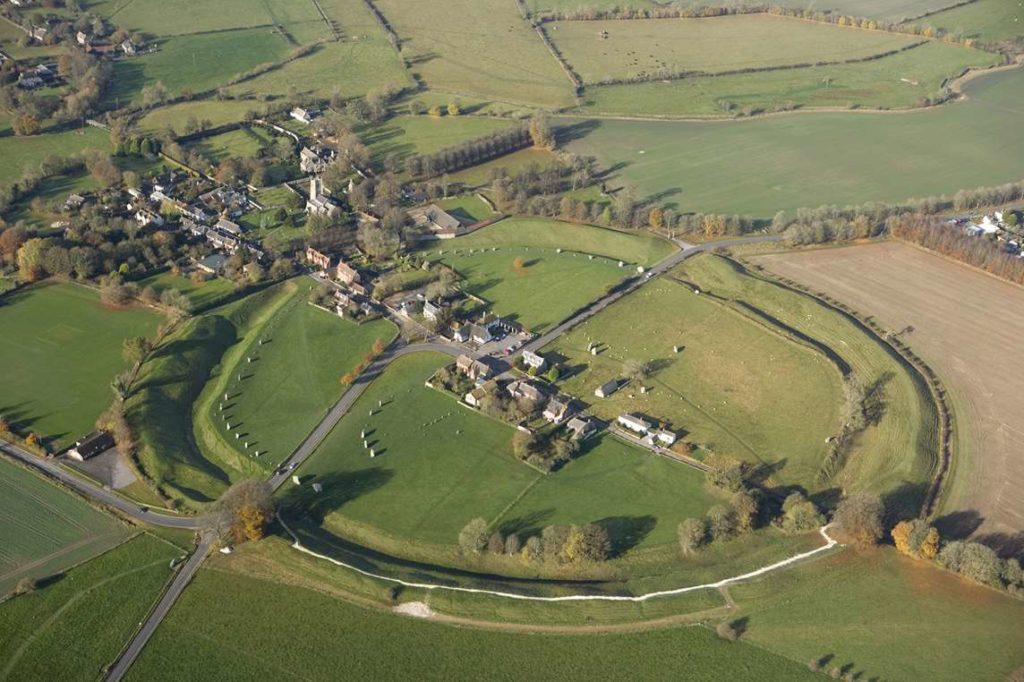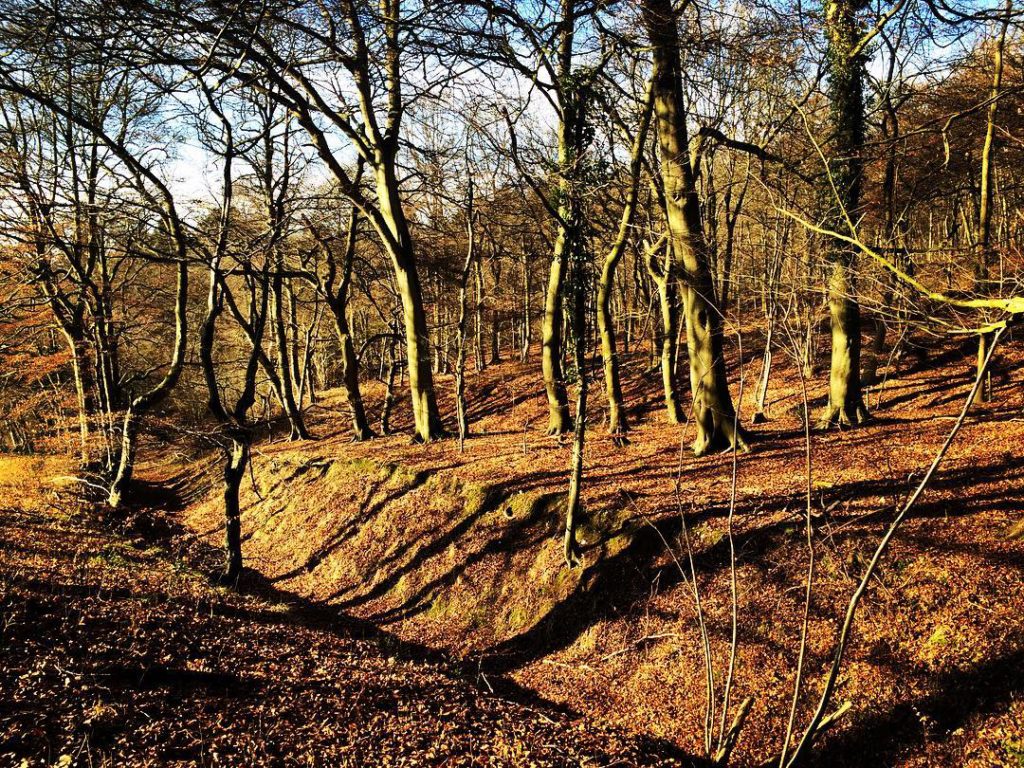Walking the Ridgeway
There is something about the winter that makes it different from other times of the year, but it is not the cold. It is not the cold breath that escapes whenever you exhale, or the layers you put on when you go outside. It is the silence.
The silence swallows you up and surrounds you like a cocoon when you’re outdoors on a winter’s morning, especially when you’re lost and confused in the woods. Which is why I leapt out of my skin when I heard the whistle- sharp and shrill.
First the whistle, then the shriek. “Abby, you silly dog, come here!” I turn to see a flash of brown streak past, all paws and ears and a lolling pink tongue. I jump out of the way as a young woman rushes past me, pursuing said flash of brown. Within seconds, she and her dog dissolve into the trees and I am alone again.
I watch their shadows disappear. Was that real? Was she real? Then I remember- the trail I am on is haunted by a black dog, not a brown one.
Ancient trails
I am on the Ridgeway, a trail 139kms long. First used by prehistoric man 5,000 years ago, the Ridgeway is Britain’s oldest walking trail, an ancient thoroughfare that dates back to the Stone Age when humans began wandering in search of drier land and better hunting grounds.
Over the centuries the trail was used by the Romans and Saxons, as well as travellers, merchants and sheep drovers. These wanderings led to settlements close to the trail and even now, particularly along the western half of the Ridgeway, there is evidence of life: Neolithic burial mounds, Iron Age forts and ancient tombs.
I’m not completely silly for wondering whether the woman and her dog are real, for a trail as ancient as this has its share of stories. There have been sightings of Roman soldiers, strange black dogs, and a large, fierce white cat that appears out of nowhere, growling and hissing, refusing to let walkers pass.
My walk began two days ago in Avebury, a village close to the start of the Ridgeway. Avebury, too, has its ghosts. The local pub, which used to be a 17th– century coaching inn, is said to be haunted by the spirit of a murdered woman, whom you might see depending on how long you’ve been sitting at the bar.

Avebury from above, showing the Outer Avebury Stone Circle and Avebury Henge from http://www.english-heritage.org.uk
What makes Avebury unique is that it is the only village in Britain to be surrounded by an ancient stone circle. As you walk along the High Street, you’ll notice a series of rocks in a curved line: this is part of what used to be the outer Avebury Stone Circle, built between 2600 and 2400 BC. Comparisons will be drawn with Stonehenge, but what makes Avebury more interesting is the concentration of Neolithic sites around the village.
To walk around Avebury is to go back in time. To the south of the stone circle is a path called West Kennet Avenue which dates from 2400 BC which leads to The Sanctuary, the site of a circular wooden building which researchers say could have been an ancient temple.
To the southwest of Avebury is a hill that appears out of nowhere measuring 39.3 metres in height. Silbury Hill is man-made, and its construction would’ve been an incredible feat back in 2600 BC, considering that it took a quarter of a million cubic metres of chalk to build. Archeological digs haven’t been able to reveal why it was built.
Avebury’s stone circles and burial mounds set the mood and prepared myself for the rest of the walk. Its standing stones were shrouded in early morning mist when I arrived, looking like sentinels guarding centuries-old secrets.
Walking in Avebury taught me something else about walking in winter. It will rain, and often. And with rain, comes mud. It isn’t a sloshy, wet kind of mud which will wipe off on grass. Here the mud is thick and cakey, like biscuit dough, and adds inches to the soles of your boots.
Getting unlost
By the time I bump into the woman and her dog in Wendover Woods, the Ridgeway has swallowed me whole. I am already at home in a place that is very, very old.
It isn’t cold enough for snow in Wendover, but it is chilly enough to rid the trees of their leaves. The trees in Wendover Woods are at their barest this time of the year, without any foliage to disguise their true form. There, a tree that looks like a trident; here, one that looks like Gandalf’s staff sprouting out of the ground; while over there- rustle, rustle, rustle. I turn, expecting to see a deer or a squirrel behind me. Nothing. No black dog either.
I haven’t seen anything out of the ordinary since starting out but I’m lost and want to get unlost. I am comfortable being on my own, but the strange silence and chill in the air has magnified my aloneness.
I go on for another half an hour, convinced I am going the right way when the trail leads me to a trench that has been dug into the forest floor. The trench stretches into the forest on my left but where it meets the Ridgeway, runs alongside the trail.
I know immediately what this is- Grim’s Ditch, a series of trenches that go back to 500 BC, found mostly in southern England. Not much is known about Grim’s ditches but because they aren’t deep enough to be defensive earthworks, the trenches are believed to have been ancient land boundaries.
The actual path of the Ridgeway lies inside the ditches but my guidebook doesn’t recommend walking there, citing mud and flies as the main reasons. As I follow the ditch, a thought comes to mind. My shoeprints are making tracks on the Ridgeway today, but whose ancient footprints lie beside mine?
I have always imagined the Earth as a sponge, retaining the memories of everyone who has walked on it. If only we could see the web of footprints criss-crossing the Ridgeway over the centuries, whether barefoot or shod in rough animal hide, a Roman legionnaire’s caligae boots, the shoes of a 17th-century traveller, or modern-day trainers. What stories those feet would tell.
I leave the woods and find another walker, and ask for directions to Wendover. He points me back into the woods and two hours later after descending Boddington Hill, I’m at Wendover train station, waiting for my ride to London Marylebone.
I usually approach my walks in one go, but because of the shorter daylight hours and remoteness of stops along the Ridgeway, I decided a month ago that I would walk the trail as a series of day walks from London.
Over the past few days I had risen early and taken the Tube in my hiking gear, surrounded by commuters in their suits, jackets and briefcases on their way to work, then hopped on a train to the countryside. I would walk my heart out during the day then like them, return on the evening train.
It’s 5pm by the time I get on the London Underground. Wendover feels like a thousand years ago, and I have three days left on the Ridgeway. The trains are slowly filling up and I find myself a seat.
I lean back and try to close my eyes, but I’m distracted by a man sitting across me. He’s in his late 40s and reminds me of a certain Mr. Clooney, but it’s not me he’s checking out. He’s looking at my boots.
My boots and trouser legs are caked in dried mud. I had tried to wipe my trousers and dig out the mud from my boots with a stick, but only a proper wash will get it all off.
Mr. Clooney catches me looking at him, and he smiles and nods. I want to tell him: I’ve had to clean my boots and trousers every evening when I get back, and I will have to clean them again tonight. In time for tomorrow, which is another day.
*This story originally appeared in the New Sunday Times.
© 2017, Anis. All rights reserved.













Salam Aniss,
appreciate your write up and wish you save journey
you said man made hill(silbury hill), does it look like as any other hill..any photo